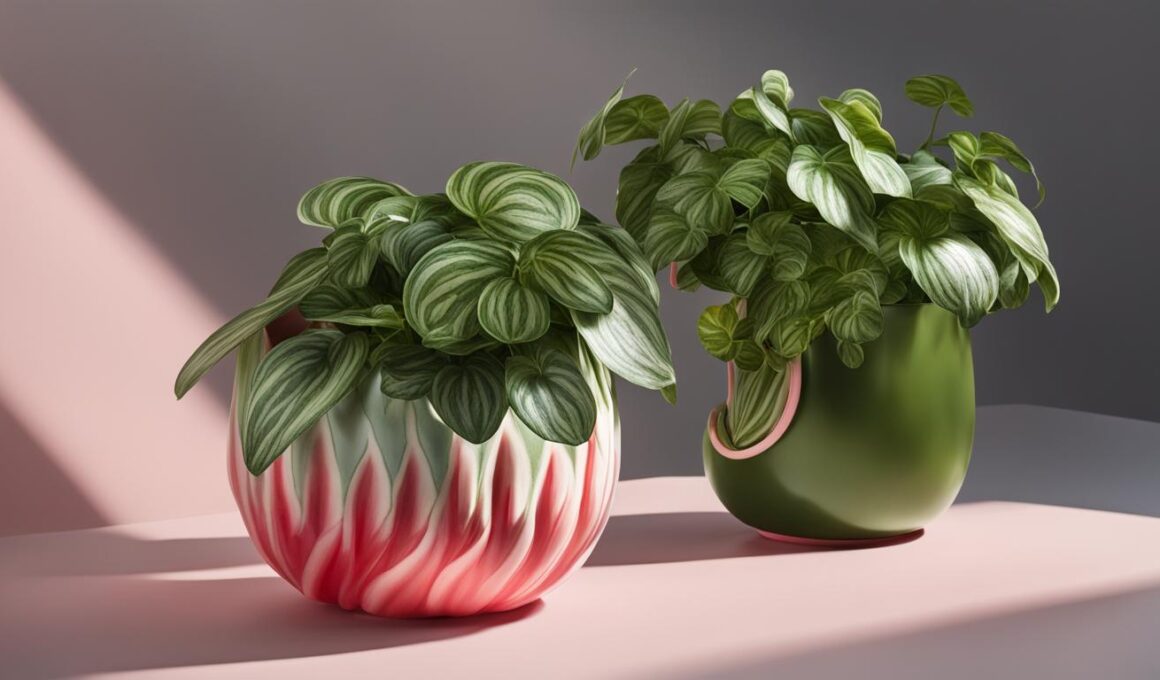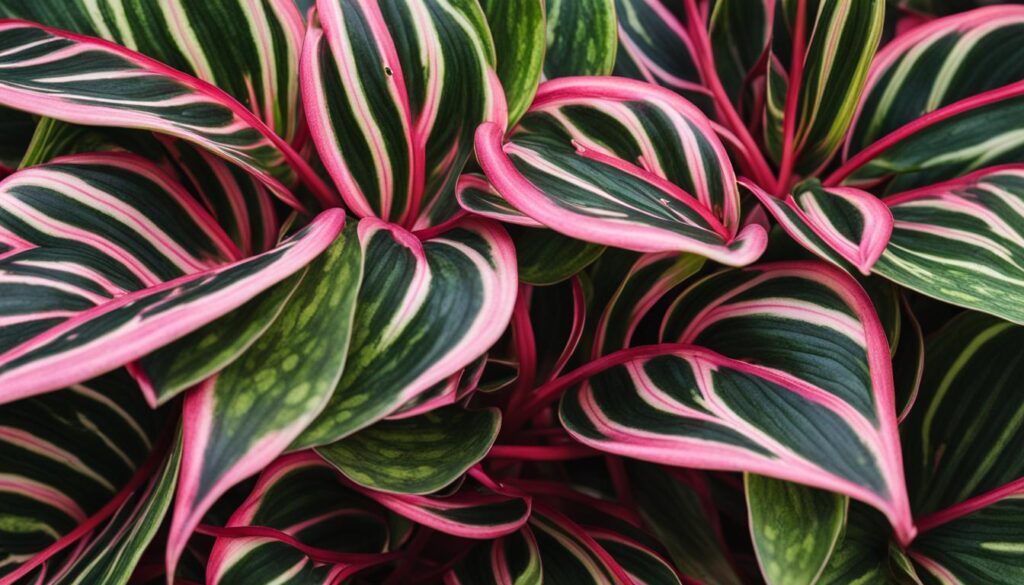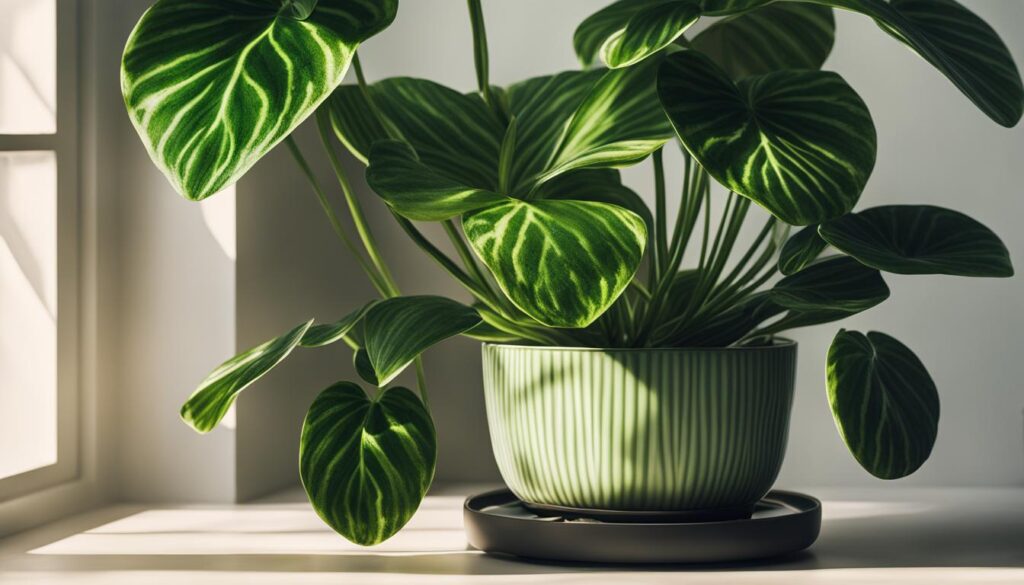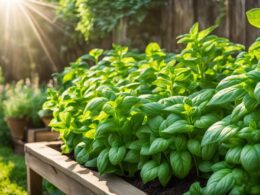Watermelon Peperomia, known botanically as Peperomia argyreia, is a highly sought-after addition to indoor gardens due to its vibrant, watermelon-patterned leaves and compatibility with household environments. Native to the tropical rainforests of South America, this compact houseplant has recently gained popularity for its easy maintenance and ability to thrive in small spaces like office desks or shelves. With the right care, Watermelon Peperomia can reach up to 12 inches in height and maintain its eye-catching foliage for years to come.
Key Takeaways
- Watermelon Peperomia is cherished for its striking, watermelon-patterned leaves and adaptability to indoor conditions.
- Proper care, including adequate indirect lighting, promotes lush growth and vibrant foliage.
- Choosing the right soil mix and maintaining a consistent watering schedule contribute to a healthy, hydrated plant.
- Replicating tropical conditions with temperature and humidity preferences ensures optimal growth and vitality.
- Propagate Watermelon Peperomia through division or leaf-cuttings to share the joy of this charming houseplant.
An Introduction to the Watermelon Peperomia
The Watermelon Peperomia, or Peperomia Argyreia, is a charming and popular houseplant that has captured the hearts of indoor gardeners around the world. As detailed in this Indoor Plant Guide, although commonly referred to as a watermelon begonia, it is not at all related to the begonia family, but instead belongs to the Piperaceae family. It’s easy to see why the Watermelon Peperomia has experienced a surge in Houseplant Popularity – with its striking foliage and easy care requirements, it makes a perfect addition to any indoor space.
Rather than boasting showy flowers, Watermelon Peperomia is celebrated for its vibrant foliage. The round, fleshy leaves feature a unique watermelon pattern, complete with green and silver hues that sparkle in the sunlight. The plant’s modest size makes it an excellent choice for small apartments or offices, as it can easily fit on a windowsill or desk. Additionally, its relatively simple care requirements make it an ideal choice for both beginner and experienced houseplant enthusiasts.
As a perennial plant native to South American rainforests, Watermelon Peperomia flourishes in indoor environments, provided it receives the proper care. In this section, you’ll find a brief overview of this stunning plant, and tips for making sure it thrives in your indoor garden.
Before we dive into the specific care requirements of Watermelon Peperomia, let’s take a closer look at some of its most appealing qualities:
- Radiant foliage: The Watermelon Peperomia’s distinct variegation patterns and lush, rounded leaves make it a visually-arresting addition to your indoor plant collection.
- Compact size: With a maximum height of 12 inches and a width of 8 inches, this plant fits perfectly on windowsills, desks, and shelves.
- Simple care: Overall, the Watermelon Peperomia is a low-maintenance plant that is well-suited for busy plant parents or those just starting their houseplant journey.
Now that you have an idea of why Watermelon Peperomia has become such a popular choice for indoor gardens, let’s explore its optimal care requirements in the following sections.
Optimal Lighting Conditions for Watermelon Peperomia
Proper lighting plays a crucial role in maintaining a healthy and attractive Watermelon Peperomia plant. By understanding and replicating the light conditions of its natural habitat, you can ensure vibrant foliage and strong growth.
Preventing Leaf Scorch with Indirect Sunlight
Being native to the rainforests, Watermelon Peperomia thrives in bright to medium indirect light. Direct exposure to sunlight can cause leaf scorch and lead to unsightly damage. To create the ideal Watermelon Peperomia Lighting, position your plant near a well-lit window or under artificial lights. However, ensure that the plant receives only indirect sunlight.
- North or east-facing window: A perfect location for softer, indirect sunlight
- Filtered light: Use a sheer curtain to diffuse the sun’s rays and avoid scorching
- Fluorescent lighting: An alternative to natural light, especially during winter months
Managing Light Intensity for Vibrant Foliage
The amount and quality of light your Watermelon Peperomia receives have a direct impact on its appearance. Insufficient lighting can result in leggy growth and smaller, less vibrant leaves, while too much light may cause leaf scorch or bleaching of the variegation. To achieve the right balance, follow these tips:
- Rotate your plant every few weeks to ensure even light exposure.
- Monitor the leaves for signs of stress. Yellowing or fading indicates too much light, whereas lack of variegation signals insufficient light.
- Adjust the distance between the plant and the light source as needed.
In conclusion, managing Indirect Sunlight and Light Intensity is essential for maintaining a healthy and visually appealing Watermelon Peperomia plant. By carefully monitoring its exposure to sunlight and making adjustments accordingly, you can enjoy a lush and vibrant houseplant that fills your space with its eye-catching, tropical beauty.
Watering Techniques for Hydrated, Healthy Plants
Proper hydration is crucial for maintaining the health and beauty of your Watermelon Peperomia. Striking the right balance between overwatering and underwatering is key to ensuring optimal growth, as both extremes can negatively impact the plant. To help you navigate this delicate equilibrium, the following guidelines outline effective watering techniques for your Watermelon Peperomia:
- Allow the top layer of soil to dry out between waterings.
- Provide a thorough watering until excess water drains out of the pot.
- Empty the saucer under the pot to prevent roots from sitting in standing water.
- Adjust your watering schedule according to changes in temperature, humidity, and light conditions.
Recognizing the signs of overwatering and underwatering is essential for the health of your plant:
| Condition | Signs | Solution |
|---|---|---|
| Overwatering |
|
|
| Underwatering |
|
|
By following the above steps, you can ensure the proper hydration of your Watermelon Peperomia, contributing to its overall health and vitality. Keep in mind that seasonal changes and environmental factors might require adjustments to your watering routine. Always observe the wellbeing of your plant and adapt accordingly to maintain its lustrous, tropical charm.
The Best Soil Mix for Thriving Watermelon Peperomia
Providing your Watermelon Peperomia with the ideal environment fuels healthy growth and flourishing foliage. A crucial component of this environment, the soil mix, plays a significant role in both moisture retention and efficient drainage. A well-balanced soil mix ensures your Watermelon Peperomia remains hydrated and healthy.
Finding the Right Balance: Moisture Versus Drainage
Striking a harmonious balance between moisture retention and drainage is vital for a thriving Watermelon Peperomia. A combination of peat moss and perlite in equal parts serves this purpose well, contributing to an ideal growing environment for the plant’s roots. Soil that is overly dry or specifically formulated for desert plants should be avoided, as this can lead to insufficient hydration.
Here is a handy table to help you determine the right combination of soil components for your Watermelon Peperomia:
| Soil Component | Description | Benefits |
|---|---|---|
| Peat Moss | A decayed plant material that retains moisture while promoting airflow. | It encourages root growth and moisture retention in the soil mix. |
| Perlite | Vitro volcanic glass used to reduce soil compaction and improve drainage. | It enhances aeration and drainage, preventing waterlogging and root rot. |
With the proper soil mix in place, your Watermelon Peperomia can showcase its lush, decorative foliage. Ensuring adequate moisture retention and drainage, while avoiding overly dry or desert plant-specific blends, will contribute significantly to the overall well-being of your plant and its ability to thrive in your indoor space.
Temperature and Humidity Preferences
As tropical houseplants, Watermelon Peperomias thrive in environments that mimic the conditions found in their natural habitat. In order to provide the optimal setting for your plant to grow and flourish, it is important to be mindful of the temperature and humidity levels in your home.
Maintaining a Tropical Environment at Home
Watermelon Peperomia temperature requirements are fairly easy to meet. These plants prefer temperatures ranging from 65-75ºF (18-24ºC), which make them well-suited for most indoor environments. However, it is crucial to minimize drastic fluctuations in temperature to ensure the plant’s health and vitality.
While average indoor humidity levels are generally sufficient for Watermelon Peperomias, maintaining a higher humidity level can further encourage their growth. Here are some methods to help optimize indoor humidity levels for these popular tropical houseplants:
- Misting: Regularly misting your Watermelon Peperomia creates a humid microclimate around the plant, which simulates rainforest conditions.
- Humidifiers: Incorporating an ultrasonic or cool mist humidifier in the room where your plant is positioned can effectively increase the overall indoor humidity levels.
- Grouping: Placing your Watermelon Peperomia in close proximity to other humidity-loving houseplants can help maintain a higher humidity level, as plants continuously release moisture into the air through a process called transpiration.
- Water Trays: Positioning your plant’s pot on a tray filled with pebbles and water can facilitate moisture evaporation, generating increased humidity around the plant. Make sure the water does not touch the pot base to avoid root rot.
By ensuring the ideal temperature and humidity levels, you can provide your Watermelon Peperomia with the necessary conditions to stay healthy, lush, and vibrant.
Propagation Methods: Sharing the Watermelon Peperomia Love
Watermelon Peperomia propagation is an exciting experience for plant lovers wishing to share their cherished greenery with friends and family. Two popular methods for propagating Watermelon Peperomia are leaf cuttings and plant division. Both techniques allow you to create brand new plants from your existing ones while ensuring a high success rate. This section will detail everything you need to know about these propagation methods.
Watermelon Peperomia Propagation: Leaf Cuttings
Leaf cuttings is a simple method to propagate Watermelon Peperomia plants. Start by selecting a healthy-looking leaf with vibrant coloration. Following these steps will ensure successful propagation:
- Carefully slice the leaf in half, preserving the petiole (the stem connecting the leaf to the main stem).
- Fill a small pot with a moistened, well-draining soil mix that incorporates equal parts peat moss and perlite.
- Insert each leaf half into the soil, burying about half an inch of the petiole for stability and to encourage root growth.
- Keep the soil consistently moist and place the pot in a location with bright, indirect sunlight.
Following these steps during the spring or summer months is crucial for the optimal growth of new plants.
Watermelon Peperomia Propagation: Plant Division
Plant division is another effective method for propagating Watermelon Peperomia. This technique involves separating the offshoots or smaller plant clusters from the parent plant and repotting them. Follow these steps to propagate by division:
- Gently remove the plant from its current pot, taking care not to damage the root system.
- Locate offshoots or smaller plant clusters, ensuring that each has its roots and leaves.
- Using clean, sharp pruning shears or scissors, carefully separate the offshoots from the main plant by making a clean cut at the junction between the offshoot’s roots and the main root ball.
- Repot the offshoots individually in prepared pots containing the same soil mix mentioned earlier—equal parts peat moss and perlite.
- Water the newly potted offshoots and place them in a location with bright, indirect sunlight.
As with leaf cuttings, spring and summer are the best times for success with plant division.
| Propagation Method | Description | Optimal Time of Year |
|---|---|---|
| Leaf Cuttings | Propagation by slicing leaves and planting them in moist soil | Spring and Summer |
| Plant Division | Propagation by separating offshoots and repotting them | Spring and Summer |
By experimenting with Watermelon Peperomia propagation methods, you can add more lush, tropical foliage to your indoor gardens. Keeping in mind the preferred growing conditions will ensure the successful growth of your newly propagated plants.
What Are the Best Care Practices for Watermelon Peperomia to Prevent Drooping?
To revive your drooping watermelon peperomia, it’s important to ensure proper care practices. This includes providing bright, indirect light, allowing the soil to dry out between waterings, and maintaining a consistent humidity level. Additionally, regular pruning and fertilizing can help promote healthy growth and prevent drooping.
Conclusion
Bringing Watermelon Peperomia into your indoor garden is a rewarding experience. Its low-maintenance nature paired with its visually appealing foliage makes it an ideal houseplant for both novice and experienced plant enthusiasts. To achieve flourishing Watermelon Peperomia growth, it is crucial to adhere to proper care guidelines, such as providing optimal lighting conditions, appropriate watering techniques, suitable soil mixes, and maintaining comfortable temperature and humidity levels.
Creating and sustaining a lush, indoor houseplant haven requires patience and dedication. However, by following the care instructions discussed throughout this article, you can ensure your Watermelon Peperomia remains healthy and vibrant. This tropical perennial offers a touch of natural charm, effortlessly transforming your living space into a captivating green oasis.
In conclusion, the Watermelon Peperomia is a worthwhile addition to any collection of houseplants. Its unique watermelon-patterned leaves and adaptable nature can bring joy and serenity to any indoor space. With the right care, this spectacular plant can truly thrive, filling your home with an atmosphere of indoor houseplant bliss.












